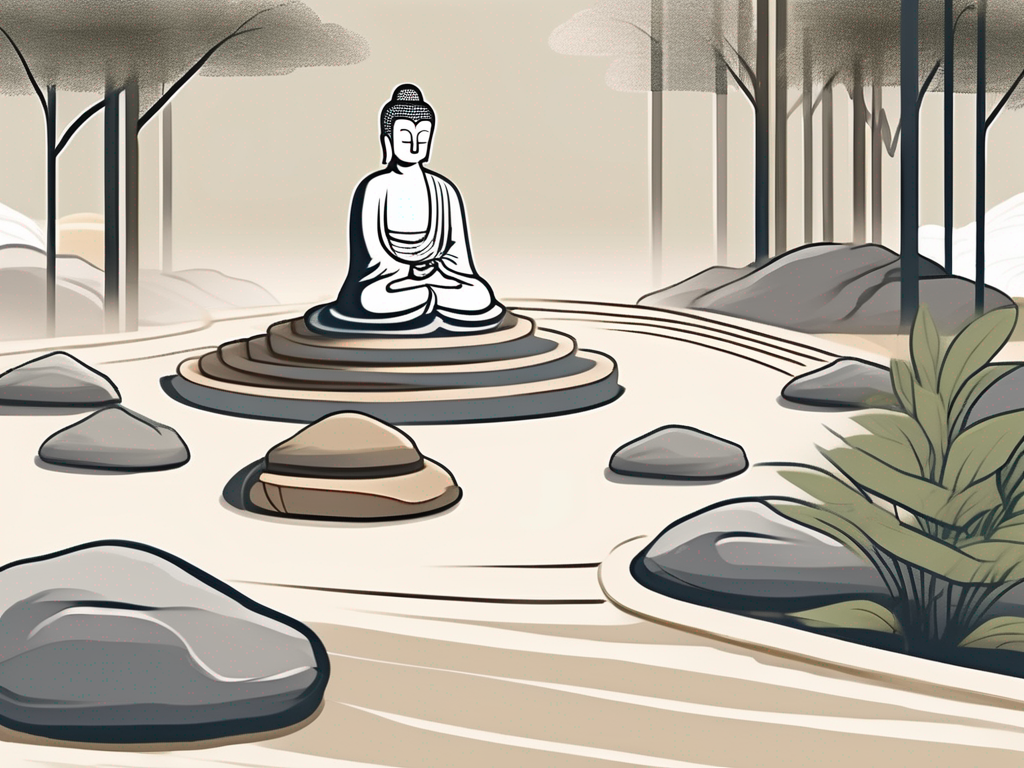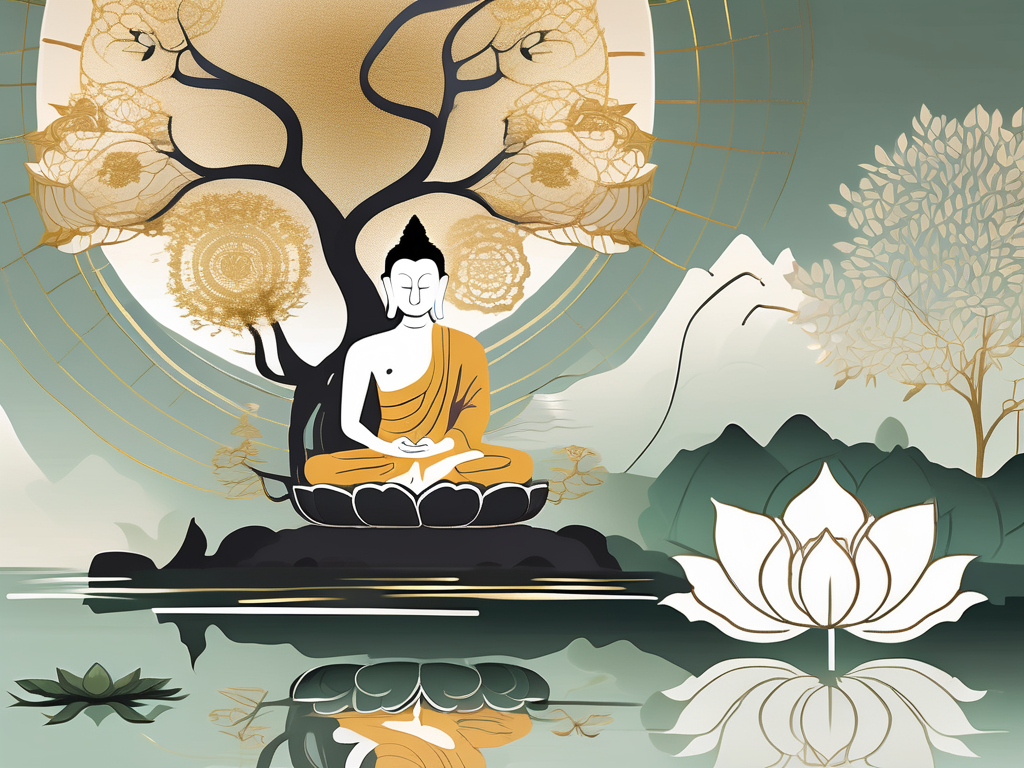Chan Buddhism, also known as Zen Buddhism, is a unique and fascinating school of Buddhism that has captivated practitioners and scholars alike for centuries. This article aims to provide an in-depth exploration of the core beliefs of Chan Buddhism, shedding light on its origins, key principles, and its influence on culture and society.
Origins and History of Chan Buddhism
Chan Buddhism traces its origins back to the 6th century in China, during a period of profound political and social change. It emerged as a response to the institutionalization and intellectualization of Buddhism, which had become prevalent at the time. Chan Buddhism sought to bring back the essence of Buddhism by placing emphasis on direct experience and intuitive insights.
The birth of Chan Buddhism can be attributed to the Indian monk Bodhidharma, a legendary figure who is said to have traveled to China during the 5th century. Bodhidharma’s arrival in China marked a significant turning point in the development of Buddhism in the region. He brought with him the teachings that would later form the basis of Chan practice.
Bodhidharma’s emphasis on meditation and mindfulness, rather than doctrine and rituals, laid the foundation for what would become the Chan tradition. He believed that true understanding and enlightenment could only be attained through direct experience and personal realization. This departure from the traditional Buddhist approach resonated with many Chinese practitioners who were seeking a more immediate and experiential path to spiritual awakening.
Over time, Chan Buddhism evolved and spread throughout China, gaining popularity among both the educated elite and the common people. The Chan masters, known as “Ch’an Zong,” played a crucial role in the development and transmission of the teachings. These masters, through their own direct experiences and insights, became renowned for their ability to guide others on the path to enlightenment.
Chan Buddhism drew inspiration from various sources, including other Buddhist schools, Taoism, and indigenous Chinese traditions. This unique blend of influences gave rise to a distinct philosophical and meditative approach that sets Chan Buddhism apart from other Buddhist traditions. The emphasis on direct experience, the use of paradoxical language, and the importance of the teacher-student relationship are some of the defining characteristics of Chan practice.
Throughout its history, Chan Buddhism has undergone periods of growth and decline, adapting to the changing social and political landscape of China. It has also spread beyond China’s borders, influencing the development of other East Asian Buddhist traditions such as Zen in Japan and Seon in Korea.
Today, Chan Buddhism continues to thrive as a living tradition, with practitioners around the world seeking to cultivate mindfulness, insight, and awakening through meditation and direct experience. Its teachings and practices offer a profound and transformative path for those who are drawn to its unique approach.
Key Principles of Chan Buddhism
Central to Chan Buddhism are three key principles: mindfulness, meditation, and the doctrine of sudden enlightenment.
Mindfulness, or “present moment awareness,” is a cornerstone of Chan practice. It involves bringing full attention to every aspect of one’s experience, whether it be sitting in meditation, walking, eating, or engaging in daily activities. By cultivating mindfulness, practitioners aim to develop a deep understanding of the nature of reality and their own minds.
In the practice of mindfulness, Chan Buddhists strive to be fully present in each moment, observing the sensations in their bodies, the thoughts passing through their minds, and the emotions arising within them. By paying close attention to these experiences, practitioners gain insight into the impermanent and interconnected nature of all things. They begin to see that everything is in a constant state of change, and that clinging to any particular experience or identity only leads to suffering.
Through the practice of mindfulness, Chan Buddhists also learn to cultivate compassion and loving-kindness towards themselves and others. By being fully present and attentive, they are able to respond to the needs and suffering of those around them with empathy and understanding.
Meditation lies at the heart of Chan Buddhism. It is through the practice of meditation, particularly seated meditation known as zazen, that practitioners strive to attain a state of deep concentration and insight. By quieting the mind and observing thoughts and sensations without judgment, one can discover their true nature and realize their inherent Buddha-nature.
In the practice of meditation, Chan Buddhists sit in a stable and upright posture, allowing the body to be relaxed and alert. They focus their attention on the breath, using it as an anchor to bring their awareness back to the present moment whenever the mind wanders. Through sustained practice, they develop the ability to observe their thoughts and emotions without getting caught up in them, cultivating a sense of inner calm and clarity.
As practitioners deepen their meditation practice, they may experience moments of stillness and insight, where the boundaries between self and other, subject and object, dissolve. In these moments, they may glimpse the interconnectedness of all things and experience a profound sense of unity and oneness.
The doctrine of sudden enlightenment teaches that enlightenment is not a gradual process but can be experienced in a single moment of complete insight. This radical idea challenges the traditional notion of spiritual progress and emphasizes the direct experience of awakening.
In Chan Buddhism, sudden enlightenment is often described as a sudden “awakening” or “seeing into one’s true nature.” It is a moment of profound clarity and understanding, where all delusions and attachments fall away, revealing the true nature of reality. This moment of insight is said to be beyond words and concepts, transcending the limitations of ordinary perception.
While sudden enlightenment can occur spontaneously, it is also seen as the culmination of dedicated practice and preparation. Chan Buddhists engage in rigorous meditation and mindfulness training, creating the conditions for insight to arise. They cultivate a deep sense of inquiry and curiosity, constantly questioning their assumptions and seeking to penetrate the nature of reality.
Chan masters often use paradoxical statements, known as “koans,” to provoke their students into a direct experience of sudden enlightenment. These koans are nonsensical or contradictory statements that cannot be solved through logical thinking. Instead, they are meant to disrupt the ordinary thought patterns and concepts, opening the mind to a direct experience of reality beyond dualistic thinking.
Ultimately, the doctrine of sudden enlightenment points to the possibility of awakening in every moment. It reminds practitioners that enlightenment is not a distant goal to be achieved in the future, but a potential that is always available here and now. By fully embracing the present moment with mindfulness and meditation, Chan Buddhists seek to cultivate the conditions for sudden enlightenment to arise and transform their lives.
Chan Buddhism Vs Other Buddhist Schools
When comparing Chan Buddhism to other Buddhist schools, several differences in practice and beliefs become apparent.
Unlike some schools that place significant importance on scriptural study and rituals, Chan Buddhism focuses more on direct experience and intuitive understanding. While textual study is not disregarded, it is seen as a means to gain wisdom rather than an end in itself.
Chan Buddhism is also characterized by unique aspects that distinguish it from other Buddhist traditions. Koans, paradoxical statements or questions, are often used by Zen masters to provoke insights and break through conceptual thinking. The use of koans in teaching sets Chan Buddhism apart, encouraging practitioners to transcend dualistic thinking and arrive at direct experience.
Furthermore, Chan Buddhism emphasizes the importance of meditation as a central practice. Meditation is seen as a way to cultivate mindfulness, concentration, and insight. In Chan Buddhism, practitioners are encouraged to engage in sitting meditation (zazen) for extended periods, often in a cross-legged position. Through the practice of meditation, Chan Buddhists aim to develop a deep awareness of the present moment and to gain insight into the nature of reality.
In addition to meditation, Chan Buddhism places great emphasis on the role of the teacher-student relationship. In this tradition, a close bond between the master and the disciple is considered crucial for spiritual growth. The teacher serves as a guide, offering guidance and instruction to the student, while the student learns through observation, imitation, and direct interaction with the master. This close relationship fosters a sense of trust, respect, and devotion, which is believed to be essential for the transmission of wisdom and insight.
Another distinguishing feature of Chan Buddhism is its emphasis on non-duality. Unlike some other Buddhist schools that may focus on the concepts of self and non-self, Chan Buddhism seeks to transcend such dualistic thinking altogether. It encourages practitioners to go beyond the limitations of language and conceptual understanding, aiming to directly experience the interconnectedness and interdependence of all phenomena. This non-dualistic approach allows for a more direct and immediate experience of reality, free from the constraints of intellectual analysis.
Moreover, Chan Buddhism often incorporates elements of nature and the natural world into its teachings and practices. The beauty and tranquility of natural surroundings are seen as conducive to spiritual awakening and deepening one’s understanding of the Dharma. Many Chan monasteries are located in serene and secluded environments, such as mountains or forests, providing a peaceful and harmonious setting for meditation and contemplation.
Lastly, Chan Buddhism places great importance on the cultivation of moral virtues and ethical conduct. Practitioners are encouraged to live a life of compassion, kindness, and mindfulness, not only in their formal meditation practice but also in their daily interactions with others. This emphasis on ethical behavior is seen as essential for the development of wisdom and the attainment of enlightenment.
In conclusion, while there are similarities between Chan Buddhism and other Buddhist schools, such as the belief in the Four Noble Truths and the practice of mindfulness, there are also distinct differences that set Chan Buddhism apart. The focus on direct experience, the use of koans, the emphasis on meditation, the teacher-student relationship, the non-dualistic approach, the integration of nature, and the cultivation of moral virtues all contribute to the unique character of Chan Buddhism.
The Role of Zen Masters in Chan Buddhism
In Chan Buddhism, the relationship between a Zen master and their student is of utmost importance. The Zen master acts as a spiritual guide, offering guidance and instruction to the student on their path towards enlightenment.
One distinctive feature of this relationship is the use of koans, mentioned earlier. Zen masters will pose these seemingly unsolvable riddles to their students, encouraging them to delve deeply into their own consciousness and confront the limits of conceptual thinking. Through this process, students may experience a breakthrough, leading to a profound realization.
As the student embarks on their journey under the guidance of the Zen master, they enter a world of rigorous discipline and intense introspection. The Zen master, with their years of experience and deep understanding of the teachings, becomes a beacon of wisdom and compassion for the student.
During the student’s training, they engage in various practices such as meditation, chanting, and mindfulness. These practices help cultivate a state of heightened awareness and focus, allowing the student to observe their thoughts and emotions without attachment or judgment.
Within the Zen monastery, the student lives a simple and austere life, stripped of worldly distractions. They follow a strict schedule, waking up before dawn to engage in morning meditation and participating in communal activities such as work and meals. This structured environment provides the student with a sense of stability and routine, allowing them to fully immerse themselves in their spiritual practice.
Throughout the student’s journey, the Zen master serves as a constant source of inspiration and guidance. They offer individualized instruction, tailoring their teachings to the unique needs and challenges of each student. Through their words and actions, the Zen master embodies the teachings of Chan Buddhism, demonstrating the possibility of awakening and liberation.
In addition to their role as a teacher, the Zen master also serves as a spiritual friend and mentor. They provide emotional support and encouragement, helping the student navigate the ups and downs of their spiritual journey. The student can confide in the Zen master, sharing their doubts, fears, and insights, knowing that they will be met with understanding and compassion.
As the student progresses on their path, they may encounter various obstacles and hindrances. These could be internal struggles such as doubt, attachment, or aversion, or external challenges such as societal expectations or personal setbacks. In such moments, the Zen master offers guidance and wisdom, helping the student navigate through these difficulties and continue their pursuit of enlightenment.
The relationship between a Zen master and their student is not one of blind obedience or dependency. Instead, it is a dynamic and transformative partnership, built on mutual trust and respect. The Zen master encourages the student to question, to challenge, and to explore, fostering a spirit of independent inquiry and self-discovery.
Ultimately, the role of the Zen master in Chan Buddhism is to facilitate the student’s awakening and realization of their true nature. Through their guidance and teachings, the Zen master helps the student transcend the limitations of the conceptual mind and experience the direct, unmediated reality of existence.
The Influence of Chan Buddhism on Culture and Society
The impact of Chan Buddhism extends far beyond the realm of spirituality. Over the centuries, it has shaped and influenced various aspects of Chinese culture and society.
One area greatly influenced by Chan Buddhism is art and literature. Paintings and calligraphy inspired by Chan principles often depict simplicity, spontaneity, and the beauty of the present moment. Poetry and literature also reflect the Chan concept of direct experience and the appreciation of everyday life.
Furthermore, Chan Buddhism’s teachings have resonated with modern society, offering a refuge from the stresses and distractions of the digital age. Its emphasis on mindfulness and meditation techniques has gained popularity in recent years, as people seek inner peace and a deeper connection with themselves and the world around them.
Conclusion
Understanding the core beliefs of Chan Buddhism provides a window into a profound and transformative spiritual tradition. From its origins to its key principles, Chan Buddhism offers a unique perspective on the nature of reality and the human mind. Its influence on culture and society demonstrates the enduring relevance of its teachings in a rapidly changing world.
Whether one seeks spiritual enlightenment, inner peace, or simply a deeper understanding of oneself and the world, exploring the core beliefs of Chan Buddhism can be a rich and rewarding journey. By embracing the principles of mindfulness, meditation, and sudden enlightenment, individuals may find themselves on a path towards greater wisdom and awakening.












